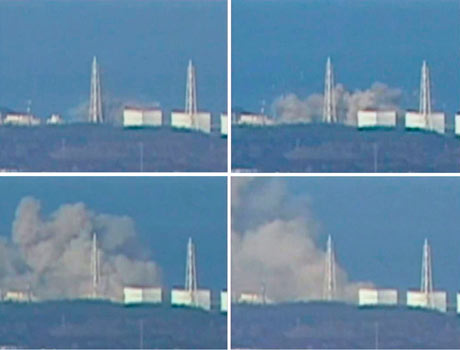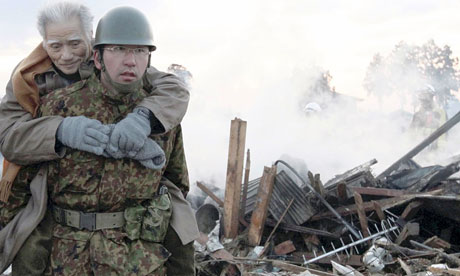On the 11th March, a 9.0 earthquake struck off the north-east coast of Japan, 130 kilometres (80 miles) from Sendai. The quake was the largest in recorded history in Japan and the tsunami that was created devastating much of the surrounding countryside. Even after three days of hard work by rescue workers the full destruction and horrors of the Japan earthquake is only now becoming clear.

Waves of tsunami hit residences after a powerful earthquake in Natori, Miyagi prefecture. (AP Photo/Kyodo News)
As the wall of water of the tsunami began to engulf the land all but the most solid structures were carried away. Cars, boats and peoples homes were all washed away, along with anyone that had not reached safety in time, or were unable to do so. Such was the force of the wave that some coastal villages simply disappeared.
Although the death-toll is still rising it is believed that at least 10,000 lost their lives in Miyagi prefecture alone, but that number is expected to rise still further, with thousands still unaccounted for. Among the statistics, individual harrowing stories are also beginning to come to light:
Harumi Watanabe’s last words to her parents were a desperate plea to “stay together” as a tsunami crashed through the windows and engulfed their family home with water, mud and wreckage
She had rushed to help them as soon as the earthquake struck about 30 minutes earlier. “I closed my shop and drove home as quickly as I could,” said Watanabe. “But there wasn’t time to save them. They were old and too weak to walk so I couldn’t get them in the car in time.
They were still in the living room when the surge hit. Though she gripped their wrinkled hands, it was too strong. Her elderly mother and father were ripped from her grasp, screaming “I can’t breathe” before they were dragged down.
Watanabe was then left fighting for her own life. “I stood on the furniture, but the water came up to my neck. There was only a narrow band of air below the ceiling. I thought I would die.”
Harumi Watanabe’s last words to her parents were a desperate plea to “stay together” as a tsunami crashed through the windows and engulfed their family home with water, mud and wreckage
She had rushed to help them as soon as the earthquake struck about 30 minutes earlier. “I closed my shop and drove home as quickly as I could,” said Watanabe. “But there wasn’t time to save them. They were old and too weak to walk so I couldn’t get them in the car in time.
They were still in the living room when the surge hit. Though she gripped their wrinkled hands, it was too strong. Her elderly mother and father were ripped from her grasp, screaming “I can’t breathe” before they were dragged down.
Watanabe was then left fighting for her own life. “I stood on the furniture, but the water came up to my neck. There was only a narrow band of air below the ceiling. I thought I would die.”
via The Guardian
The USGS reported that since the initial quake over 250 aftershocks had been detected, with 30 of those in excess of magnitude 6. As rescue teams from more than 70 countries and tens of thousands of Japanese troops descended on the disaster zone, meteorological agency officials warned there was a 70% chance of a magnitude 7.0 earthquake striking the region in the next three days, so the threat of further seismic shifts and tsunami are far from over. New Scientist have provided an interactive map to illustrate Japan’s seismic history.
One of the main concerns that have come to light as a result of the quake is the growing nuclear crisis. It was reported on Friday 11th March that the Tokyo Electric Power Company’s Fukushima-Daiichi nuclear power plant, 240km (150 miles) north of Tokyo, had been damaged causing the cooling system that regulated the temperature of the fuel rods in the reactor core to shut-down. Despite efforts by engineers to replace and repair the system the makeshift attempt to cool the No 1 plant failed, leading to a build up of superheated water inside the chamber. On Saturday, engineers released water vapour – which contained radioactive caesium and iodine – from the pressure vessel as an emergency measure, but it appears that hydrogen escaped during the venting procedure and exploded. The blast damaged several nearby buildings and injured four workers, but thankfully, the explosion happened outside the reactor’s primary containment vessel, which appears to be intact.

Smoke rises from Fukushima Daiichi No 1 plant after a blast at the power station following Japan's earthquake and tsunami. (Photo: Staff/Reuters)
On Sunday, engineers vented water vapour from a second reactor at the power station and began pumping in sea water after the cooling system at the No 3 unit also failed. Japanese authorities said there was a risk of a similar explosion as happened in the first reactor. This strategy untested however and could take several days to bring the temperature and pressure of the reactor cores down to within safe limits. The biggest worry is that if the cooling fails, the reactors could overheat and cause a total meltdown of the radioactive fuel rods in the core if the reactor’s containment vessel was breached. Officials are also concerned that if there is another large aftershock, as mentioned above, it could further destabilise the plant. Because of the continuing danger, tens of thousands of local residents have been evacuated from the 20km exclusion area.
The scale of this tragedy is hard to fathom, but to give an example of the sort of forces involved, NASA Jet Propulsion Laboratory’s (JPL) specialist Richard Gross, stated that the earthquake not only caused Japan to shift positive by 2.4 metres but that it had altered the Earth’s figure axis (the axis around which the Earth is balanced by mass) by about 15 centimetres – 2 times greater than after the Chilean earthquake of 2010.
“According to my calculations, the length of the day should be reduced to 1.6 microseconds (millionths of a second). The earthquake in Chile gave, in my opinion, a reduction of approximately 1.2 microseconds,” he said.
That may not sound like a lot but the fact that a single event can have an impact like that at all is staggering.
There are to many stories to note in a single blog post, and more is being revealed all the time, so this is but the briefest of overviews. The power that was unleashed on the 11th March was humbling, but it is when you read the stories of personal tragedy and miraculous survival that the affects of this event really starts to sink in. These stories and photographs are heartbreaking, but the full horrors are impossible to imagine. So many families and communities have been torn apart and countless lives have been changed forever. Organizations such as the Red Cross have started up appeals to try and help the victims and I urge you to give what you can. More will be revealed as the days and weeks go on, and more quakes will be felt, so it will be up to the brave rescue services from around the world to try and save as many lives as possible, in the most difficult of circumstances.







Leave a comment